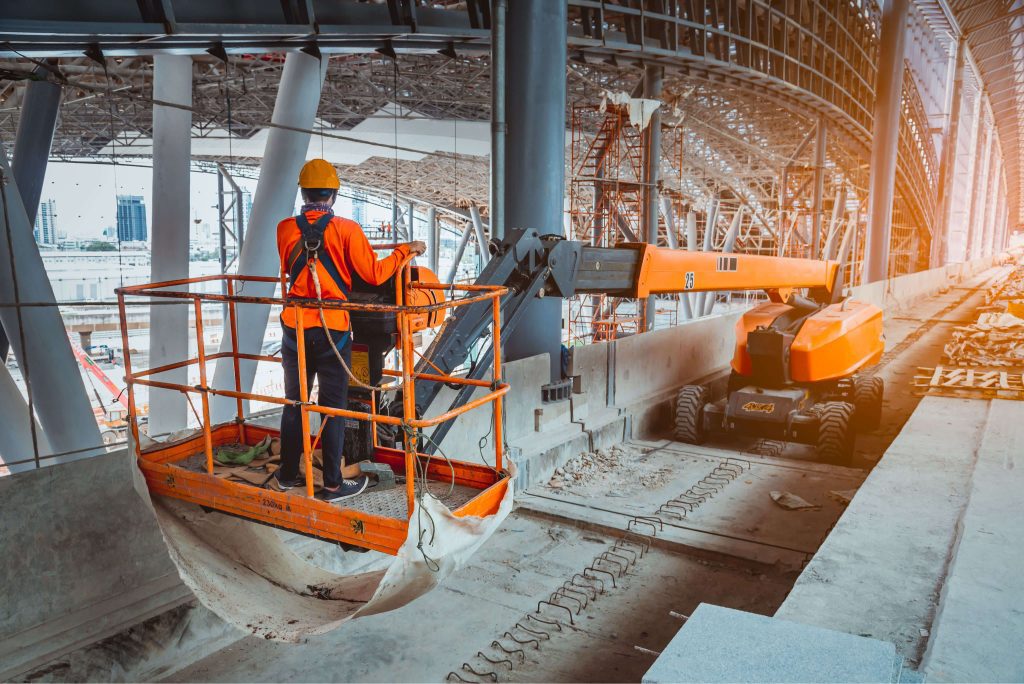
Using Aerial Lifts – Facts and Hazards
Aerial lifts are important tools used in many jobs, like construction and maintenance. These machines, which include cherry pickers and bucket trucks, help workers reach high places safely. However, using aerial lifts can be dangerous if not done correctly. The main risks are falling, getting electrocuted, or the lift tipping over. To stay safe, workers need to follow certain rules and be properly trained. This blog and PDF Download will explain the key safety tips for using aerial lifts, working near power lines, avoiding getting hit or trapped by equipment, and preventing falls.
Safe Work Practices for Aerial Lifts
There are crucial steps to using an aerial lift safely, and the first is proper training:
- Workers need to know how to operate the lift, test the controls, and inspect it before each use. It’s important that all the controls are clearly labeled so workers know what each one does.
- One important rule is to never override the safety devices on the lift. These devices are there to keep everyone safe. \
- Workers should also follow the manufacturer’s instructions for using and maintaining the lift.
- Aerial Lift Operators should always stand firmly on the basket floor and never sit or climb on the edges. Using things like planks or boxes to reach higher is not advised because it can make the lift unstable and cause falls.
Load Stability
Stability is very important. Here are some steps to take to ensure that you have a stable load while operating an Aerial Lift:
- All the wheels of the lift should be on a solid base, and outriggers (extra supports) should be used if available.
- When working on a slope, workers should set the brakes and use wheel chocks to keep the lift from moving.
- Be careful not to exceed the lift’s weight limit, including the weight of the workers, tools, and materials.
- Before doing any maintenance or repairs on the lift, the machine should be turned off and locked to make sure it can’t be used accidentally. This helps prevent injuries.
Working Near Power Lines
Working near power lines is especially dangerous because of the risk of electrocution. Here are some hazards to consider:
- To stay safe, workers should keep at least 10 feet away from the nearest power line. This rule also applies to any metal objects they might be using, like wires or pipes.
- All power lines should be treated as if they are live, even if they look like they are down or insulated. This helps prevent accidental contact with live wires, which can be very dangerous.
- Only specially trained workers, like power line technicians, are allowed to work closer than 10 feet to a power line.
Struck-by, Crushed-by, or Caught-in Hazards
Aerial lift operations can also pose risks of getting hit, crushed, or trapped by equipment. Here are some steps to avoid these dangers:
- It’s important to set up and clearly mark a danger zone around the lift. This keeps unauthorized people at a safe distance.
- Moving the lift with workers in the basket is usually not allowed unless the lift is designed for it. This helps prevent falls and other accidents.
- Workers should also avoid standing between overhead hazards, like beams, and the basket rails. If the basket moves, they could get trapped and crushed.
Fall Protection
One of the most important aspects of Aerial Lift operation is the topic of Fall Protection:
- Workers should not attach themselves to nearby poles, structures, or equipment while in the lift.
- Instead, they should use a body harness or positioning device with a lanyard attached to the boom or basket.
- This setup helps keep them from being thrown out or pulled from the basket.
Conclusion
In conclusion, using aerial lifts safely requires knowing how to operate them, following safety rules, and getting proper training. By following these tips, staying a safe distance from power lines, avoiding getting hit or trapped by equipment, and using fall protection, workers can greatly reduce the risk of accidents and injuries. Keeping everyone safe not only protects workers but also helps get the job done more efficiently.
Source
https://www.osha.gov/sites/default/files/publications/aerial_lifts.pdf